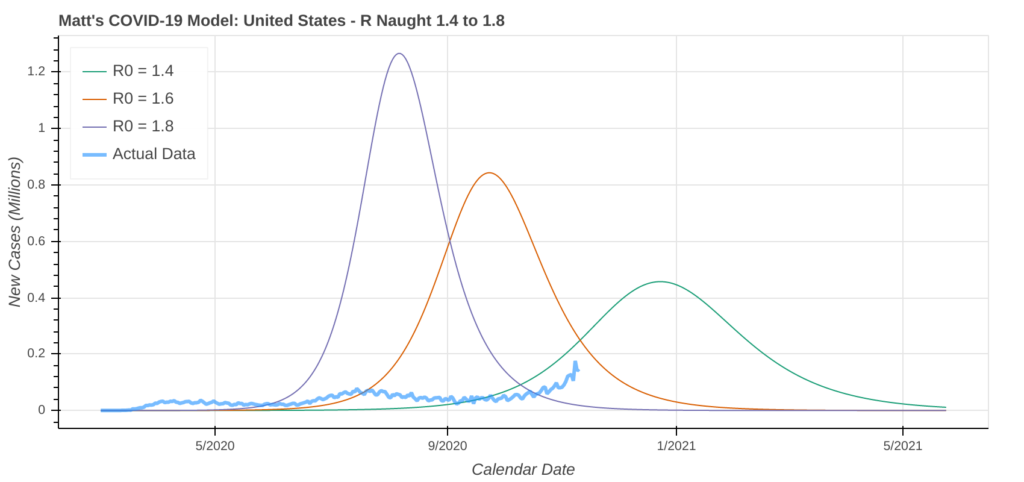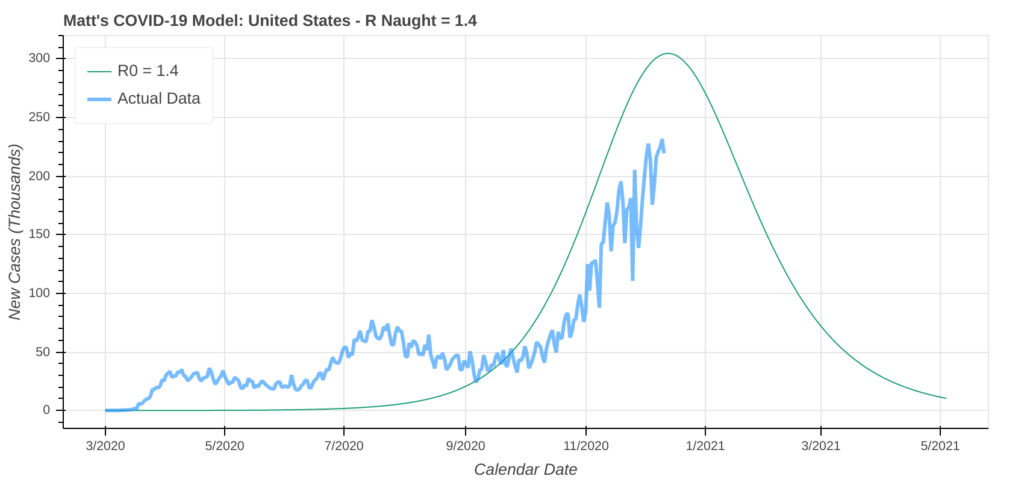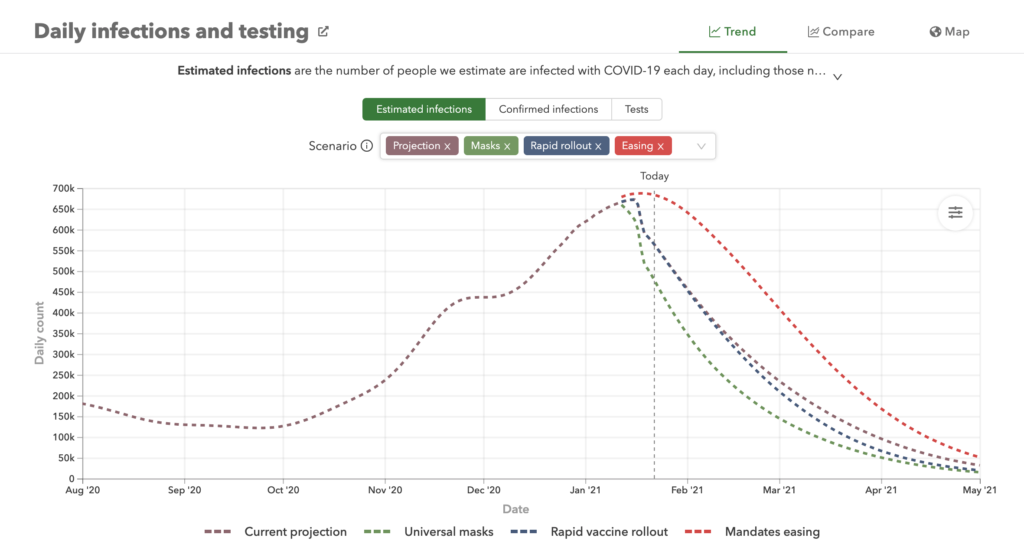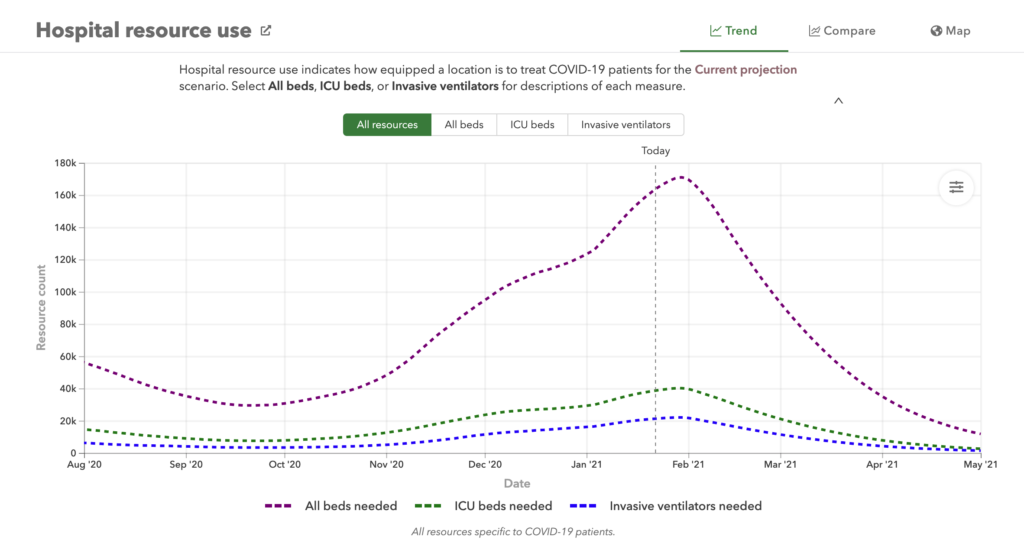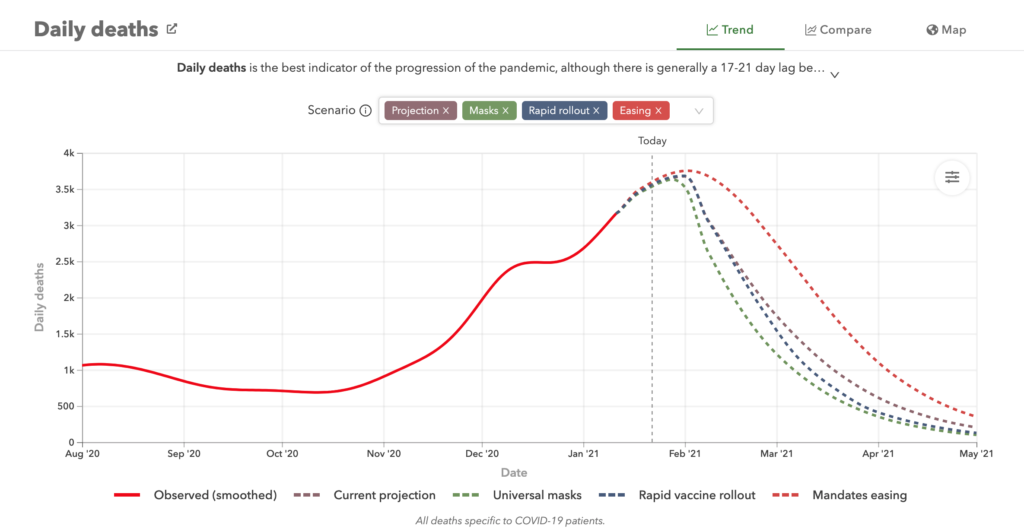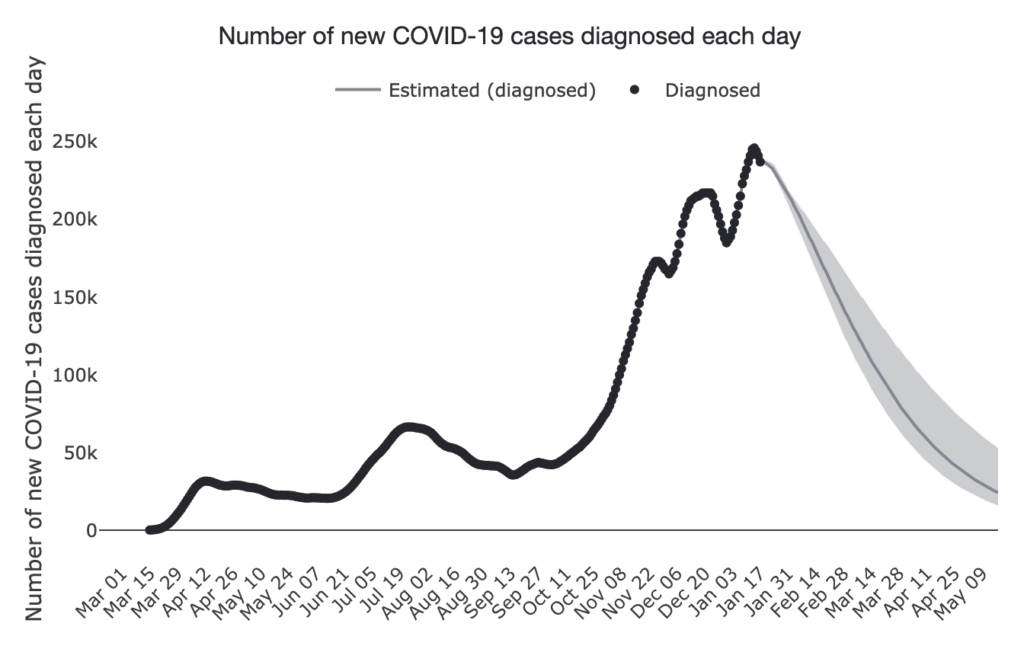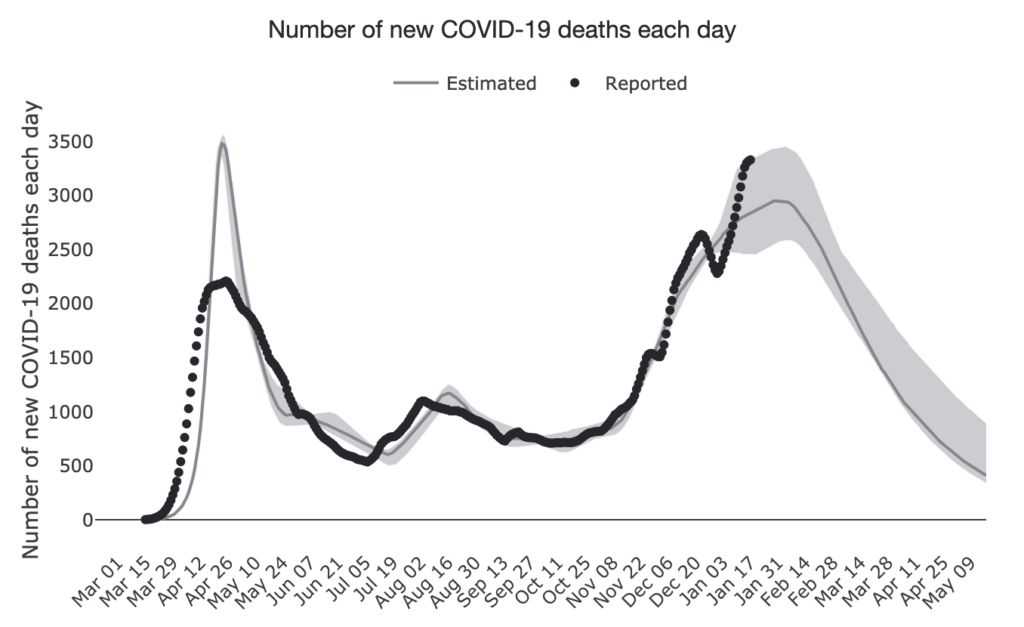Well, there’s finally a glimmer of hope in the United States’ fight against COVID-19. We’ve finally hit a peak, and new case loads are finally starting to drop. I know what you’re wondering. Is it the peak of this awful winter wave of COVID-19? The short answer is that it’s not clear yet, but I do have 7 very good reasons to be at least cautiously optimistic that we have hit the peak of the COVID-19 pandemic.
1. The Current COVID-19 Peak Lines Up Almost Perfectly with Our November, 2020 COVID-19 Forecast.
Recall that on 14 November, 2020, we looked at several reputable COVID-19 models. Based on those models, we created a prediction for the COVID-19 pandemic using the same methodology weather forecasters use. Here is the forecast we made.
– The peak of the winter wave will occur around New Year’s Day (1 January, 2021).
– There will be 320,000 to 400,000 new daily COVID-19 cases in the United States at the peak of the winter wave.
– By next spring, there will be 30 to 50 million total confirmed COVID-19 cases in the United States.
Our Official Forecast on 14 November, 2020
So how did we do?
- The current COVID-19 peak occurred on 11 January, 2021 using the 7-day moving average. The United States confirmed just shy of 300,000 new cases on 2 January, 2021, setting the record for most new daily cases in a single day. What was that about the peak of the winter wave occurring around New Year’s Day?
- The 7-day average peaked just under 257,000 daily new cases, with a single day high of 299,087 cases on 2 January. Our analysis and forecast predicted 320,000 new daily cases at the peak.
- There are currently over 25 million total confirmed COVID-19 cases in the United States. Given that over 70% of those cases have been confirmed after Election Day (3 November), that forecast of 30 to 50 million cases by spring seems like a pretty safe bet right now.
2. Unlike previous dips in new COVID-19 cases, this peak is not occurring around a major holiday.
Both the Thanksgiving and Christmas holidays caused some interesting anomalies in the United States’ daily new case data.

Prior to each holiday, there was a huge excess demand for testing. People wanted to make sure they did not have COVID-19 prior to traveling. The excess demand bumped new daily cases higher than they would have been because more tests were being processed.
During the several days immediately leading up to and following each holiday, people were with their friends, family, and loved ones. Getting tested was far from being on their mind. As a result, fewer tests were being processed, and you see a sharp drop in new daily cases.
The holiday roller coaster is completed after people return home and get tested again to ensure they can safely integrate back into society at home. This surge in demand, coupled with the surge in transmission due to holiday gatherings, results in an upward spike of new cases following each holiday.
You can see the same anomalies in Canada’s COVID-19 data over the holidays. It’s interesting to note that Canadians don’t travel for Thanksgiving anywhere near as much as Americans do. You can see that in the magnitude of the anomalies.

There are no major holidays right now that could artificially lower the new daily case curves in both the United States and Canada. The current decline in cases appears to be happening naturally.
What’s even more encouraging is that Canada is seeing a drop in cases as well. Hospitalizations have leveled off and/or started to decline in many states and provinces in both the US and Canada, which also points to a natural decline.
3. Unlike artificial declines in new COVID-19 cases due to holidays, this peak has lasted much longer and is much better established.
Numbers don’t lie. The sharp artificial drop in new daily cases we saw over the holidays only lasted at most two or three days before turning around and shooting back up. The current sharp drop in new daily cases in the United States has already been going on for 11 days. In Canada, we’re on the 13th straight day of declining COVID-19 cases.
Experts have generally considered patterns in the COVID-19 pandemic to be well-established after they’ve been in place for 14 days straight. If the current trends continue, both the US and Canada will hit that magical 2 week mark early next week.
4. The US is Rolling Out and Scaling Up COVID-19 Vaccines
Unlike the spring and summer waves, COVID-19 vaccines have been approved and are beginning to roll out. It is nothing short of a miracle that these vaccines even exist right now. Prior to the COVID-19 pandemic, the mumps vaccine, which previously held the record for the fastest vaccine development, took four years to create, trial, and deem safe. The COVID-19 vaccine accomplished the same feat in 10 months.
The US is roughly on track right now to hit Joe Biden’s goal of 100 million shots in 100 days with just the two currently approved Pfizer and Moderna vaccines. The US is scaling up distribution of both vaccines as we speak, and there’s help waiting in the wings as well.
There are still 2 vaccines – Johnson & Johnson and AstraZeneca – that are in the final trial phase and will likely be approved within the next few months. It sounds like the J&J vaccine could be a game changer for scaling up vaccinations.
The Pfizer and Moderna vaccines both require two doses and special ultra-cold storage. On the other hand, the J&J vaccine only requires one shot and can be stored in a standard refrigerator. In addition to being much easier to get it into hard-to-reach areas, you can also immunize twice as many people with it. Talk about a shot in the arm (pun fully intended)! From reports I’ve heard in the news, it sounds like Johnson & Johnson will apply for emergency use authorization within the next month or so.
5. We now have a President who believes in science and actually listens to experts
The Trump administration gave us a master class in how not to respond to a major disaster. They routinely mocked and ignored their own half-assed guidelines without a plan for anything. Common sense precautions became a political statement. The nation’s top infectious disease experts were silenced and instead we were told to inject ourselves with bleach. And then there was my favorite: when you test, you create cases. Facepalm!
With a new Biden administration now formally at the helm, a return to truth, logic, and science is a very welcome sight in the fight against the COVID-19 pandemic. Want to know how much of a difference having leaders that are straight with their people and actually take the pandemic seriously? Have a look at Australia and New Zealand.
The leaders of both Australia and New Zealand used the pandemic as a rallying cry to unite their constituents and came out on Day 1 with a plan to defeat COVID-19. What was the difference? The United States recently recorded a record 4,610 deaths on 12 January alone. In New Zealand, 25 people have died in the entire pandemic. Australia has done pretty good, too. 909 Australians have died of COVID-19 since the pandemic began.
The idea that you can get up here and talk about what you know, what evidence, what the science is, and know that’s it. Let the science speak. It is somewhat of a liberating feeling.
Dr. Anthony Fauci, in a 21 January, 2021 Press Conference
6. Reputable Models Show COVID-19 Cases and Deaths Continuing to Decline Through February, March, and April.
Back in November, we looked at the IHME, the COVID-19 Simulator, and my model. Let’s revisit them all again.
IHME (University of Washington)
The IHME model shows new daily cases, hospitalizations, and deaths decreasing significantly once we get into February. If its forecast verifies, it means that the 11 January peak will have been the peak of the winter wave.
COVID-19 Simulator
Using the current COVID-19 restrictions, the COVID-19 Simulator is in agreement with the IHME model, showing a downward trend of both new daily cases and deaths.
My Model
My COVID-19 model is in agreement with both the IHME and the COVID-19 simulator. It too shows new cases significantly declining though February, March, and April.
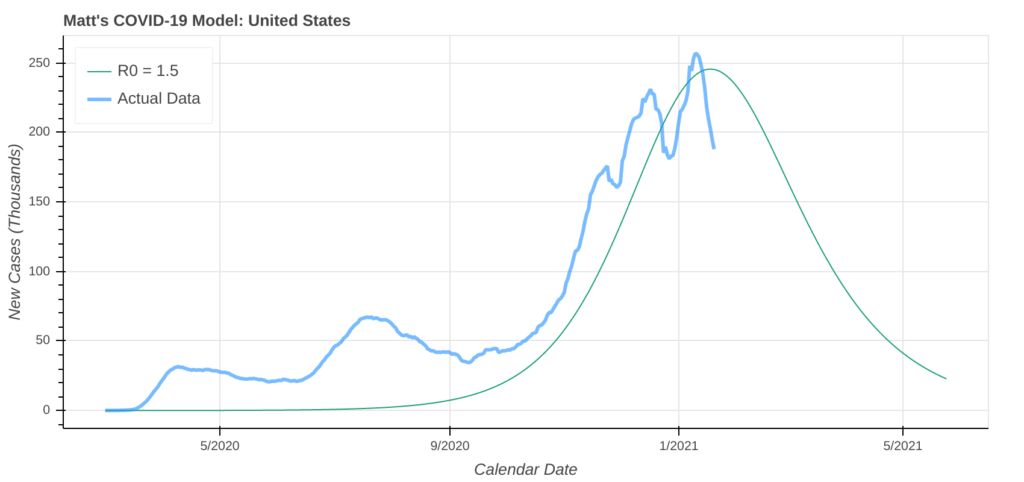
One Last Reason to be Optimistic About the Models
In the world of weather forecasting, we base our confidence in the forecasts on two factors.
- Are the models in agreement?
- Are the models stable or consistent from run-to-run?
We’ve looked at the first bullet plenty, but what about the second? Have a look back at the models’ projections in November. All three models have stayed consistent when compared to today’s projections. They’re showing basically the same outcomes today that they were showing back in November. As a result, we can be much more confident in forecasts based on these models, which are heading in the right direction.
7. Believe it or not, there is a positive silver lining to the US having the most cases in the world by far.
Any guesses as to what that may be? No? Before we jump in, I want to make it perfectly clear that this does not underscore or make light of the nearly 25 million people who have been infected or the 410,000-plus Americans who have died from COVID-19. Those numbers are beyond horrific and there is no excuse whatsoever for why or how we let those numbers get so high.
That being said, there is one silver lining to having so many people become infected in the US. Everyone who has been infected with COVID-19 has at least some natural immunity to the virus. As a result, it means the US has to vaccinate fewer susceptible people to reach herd immunity. This is especially critical given how much vaccine skepticism and hesitancy exists in the US.
Consider the following calculation. Let’s say for the sake of this argument, the US has 30 to 35 million confirmed infections by late spring. That’s roughly 10% of its total population of 330 million who already have some natural immunity.
In this scenario, to reach the 70 to 80 percent threshold for herd immunity, you only need to vaccinate 60 to 70 percent of the population. Furthermore, don’t forget that the true number of COVID-19 cases in the US is likely much higher than the number of confirmed positive tests. That only drives the number of people needing to be vaccinated to reach herd immunity even lower.
However, this is in no circumstance whatsoever a reason to not get the vaccine. Go get your shot as soon as you’re eligible.
A Final Word of Caution About the COVID-19 Peak
While there is plenty of optimism in this outlook, we mustn’t get ahead of ourselves. The pandemic is far from over and there are plenty of opportunities for things to go awry.
- The fact that we’ve hit a peak in the COVID-19 pandemic and the models show that we’ve peaked is by no means a guarantee that we have actually hit the peak.
- While cases may have peaked, hospitalizations and deaths likely have not. If in fact 11 January was the case peak, COVID-19 hospitalizations should peak within the next week or so and deaths should peak in early February.
- There are plenty of external forces that can send cases rising again that the models have little to no way to accurately predict.
- Events like the Washington, DC riots of 6 January, 2021
- More transmissible mutant strains of COVID-19 will likely become dominant in the US. The increased transmissibility or contagiousness can easily nullify the downward trend.
- Testing protocols will change as we shift from the Trump administration to the Biden administration. While these changes will not affect overall trends and patterns, they can cause anomalies in the data.
Conclusion
For the first time in months, there are signs for hope and optimism in the United States’ fight against the COVID-19 pandemic. Even if we have actually hit the peak of the COVID-19 winter wave, we cannot let up in our fight. The pandemic is far from over, and there are still months to go before the end of the current winter wave. We all have a job to do to end the pandemic. Stay the course, do your job, and we’ll be back to normal before we know it.
Top Photo: Morning Sun Breaks over the McDowell-Sonoran Preserve
Scottsdale, Arizona – October, 2017
